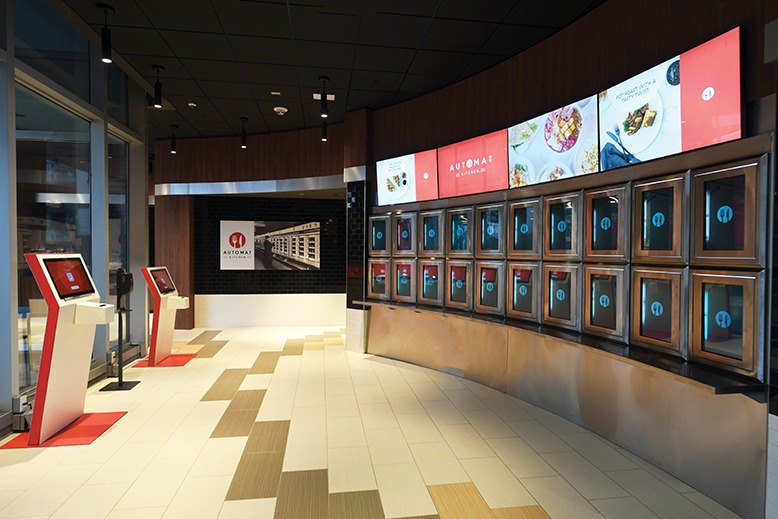
Automat Kitchen puts a 21st-century spin on the bygone, coin-operated Horn & Hardart mode of self-serve. Courtesy of Michael Tulipan MST Creative
Entering Jersey City’s Automat Kitchen, my father and I gaze across the well-lit space at the shiny wall of glass lockers. Above these cubbies, a digital screen flashes the names of diners whose orders are up. Behind the wall, sight unseen, the kitchen hustles to make pot pies, flatbreads and sandwiches, sliding the finished products into the rear-facing openings of the lockers.
In some ways, it’s quite like the automats my father lovingly recalls from his childhood. Those eateries served cheap, high-quality food via a vending system. At the Times Square location as a kid in the 1950s, he would approach the wall of glass compartments excitedly, push a nickel into a slot, turn the shiny chrome handle, and extract a plate of premade hot spaghetti or a fat slice of pie.
In other ways, he tells me, this new automat is a departure. Here, we choose our lunch at a digital kiosk (you can also order online or scan a QR code on your phone). When our food is ready, I get a text, reply to it, and door number four reveals our meal. The automat used to be a prime location for people watching, my dad says. Today, despite Automat Kitchen’s seating area, we take our food to go (in compostable packaging).
[RELATED: How Meal-Match Programs Have Come to the Rescue Throughout the Pandemic]
Behind this blend of old and new is another person with fond automat memories: owner Joe Scutellaro. A Hoboken native, Scutellaro remembers excursions with his grandmother to the automat in Manhattan. She’d get the famous coffee, dispensed from brass spigots, and give Scutellaro a coin to pop into the wall to buy a dessert. “It was just very cool,” he says.
In its day, the automat was “an astonishing success,” says culinary historian Laura Shapiro. Joseph V. Horn and Frank Joseph Hardart opened their first automat in Philadelphia in 1902, inspired by a similar concept in Germany. After the first New York location opened in 1912, Horn & Hardart Automats quickly became a city staple.
Automats stayed popular for decades, providing not only a novel experience and clean, comfortable dining rooms, but also quick bites for harried New Yorkers, says Shapiro, who co-curated Lunch Hour NYC with Rebecca Federman, a 2012 exhibit at the New York Public Library that examined more than a century of how the city and its residents shaped the midday meal. (The exhibit featured a restored Horn & Hardart automat machine.)
Diners could get a meal for just a few nickels, with no waiters to tip. But starting in midcentury, prices went up and quality declined. Automats faced competition from other casual spots and coffee shops, says Shapiro, as well as office buildings with their own cafeterias. Then came fast-food chains. Meanwhile, New Yorkers flocked to the suburbs. The last location, in midtown Manhattan, closed in 1991.
***
Scutellaro never forgot the automat, even after he grew up and moved to Brick, and especially not when he became an accountant with restaurant and hospitality clients. Bringing back the concept took years. Scutellaro’s first attempt was in the early 2000s, but “the idea was ahead of the technology,” he says. “Touch screens and cell phones weren’t there yet.”
A decade later, he decided to try again—choosing a location on the Jersey City waterfront for its proximity to high-rise office buildings and Manhattan-bound commuters. The plan was to open in April 2020. Then, the pandemic hit. He put the opening on pause, and in the interim rejiggered Automat Kitchen’s software to allow for a totally touchless experience (in addition to touch screens) before finally opening this past January.
It seems like the right moment for touchless dining with no servers. “Any kind of food service that looks safe in a pandemic is going to be appealing,” notes Shapiro, who’s also the author of What She Ate: Six Remarkable Women and the Food that Tells Their Stories. That is, she adds, “if the food is good and the prices reasonable.”
After all, high-quality food and low prices, Shapiro notes, are what made the original automats so popular. That’s not lost on Scutellaro. The menu includes two of the original favorites: chicken pot pie and macaroni and cheese. Such food pays homage to the automat’s comfort fare. But there are also updates for current tastes, such as the Massaman curry pot roast, the grain bowl, and the black beans and sofrito sauce that accompany the roast chicken. These mingle on the menu with the traditional root beer float and the grilled cheese sandwich. And while there’s “nothing for a nickel or quarter like the original automat,” Scutellaro quips, keeping things nice-priced is important. The most expensive item, the brisket-stuffed Frito pie burrito, is $17.99; a breakfast taco is $2.99.
“What’s most rewarding is getting feedback on the food,” adds Scutellaro’s son, Steve, who heads up marketing. Nostalgia alone isn’t enough, he says, “if the food and experience don’t deliver.”
***
The Scutellaros plan to open two to three more Automat Kitchens in the Northeast in the next couple of years. They’re in talks to bring the concept to airports and train stations, as well as college campuses. They’re also open to licensing their patented technology. “The applications of a system like this are endless,” says the younger Scutellaro.
Related concepts are emerging. Brooklyn Dumpling Shop, which credits Horn & Hardart as an inspiration and boasts its own touchless technology, plans to open in Hoboken this spring, according to founder Stratis Morfogen. A New Brunswick location, featuring dumplings with flavors inspired by classic diner sandwiches, is planned for summer, with additional New Jersey locations to follow.
These no-touch, to-go experiences are obviously a good fit for pandemic times. Still, what made automats successful was, in part, the dine-in atmosphere, says Shapiro. She misses restaurants as we knew them. I do, too. And even though Scutellaro says Automat Kitchen was always intended mainly for grab-and-go, he’s looking forward to seating people again. After all, the automat that generations of diners like my dad fell in love with “was a place people would go, hang out, have a cup of coffee.”
HOW TO VISIT: Automat Kitchen, 525 Washington Boulevard, Jersey City (in the Newport Tower); 201-918-5131; automatkitchen.com.



